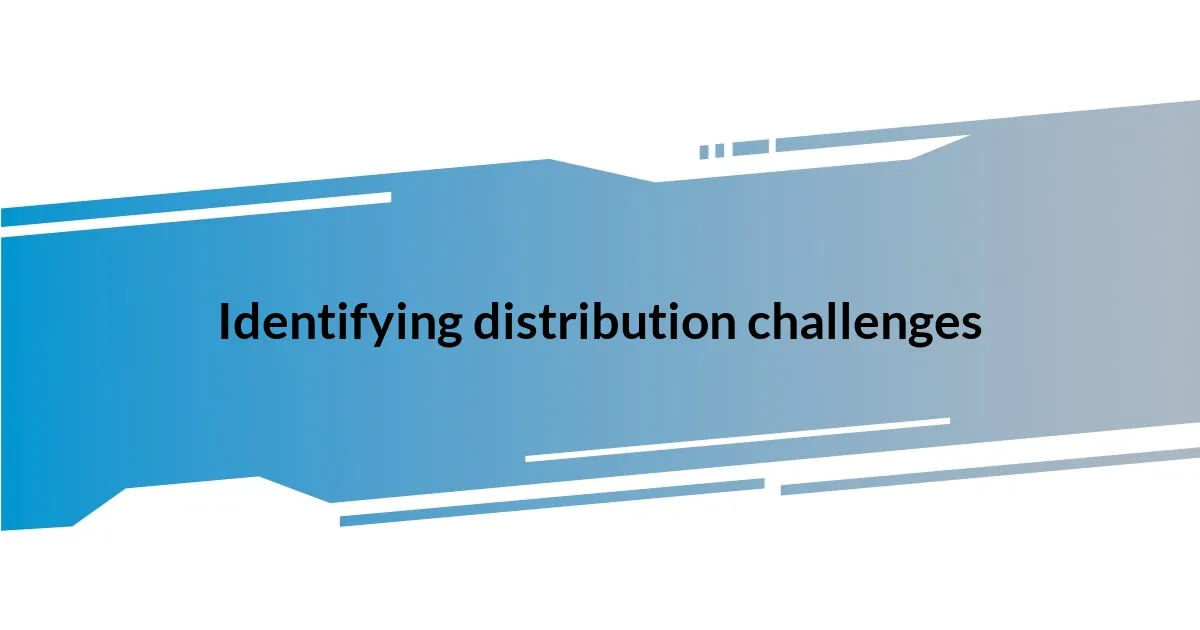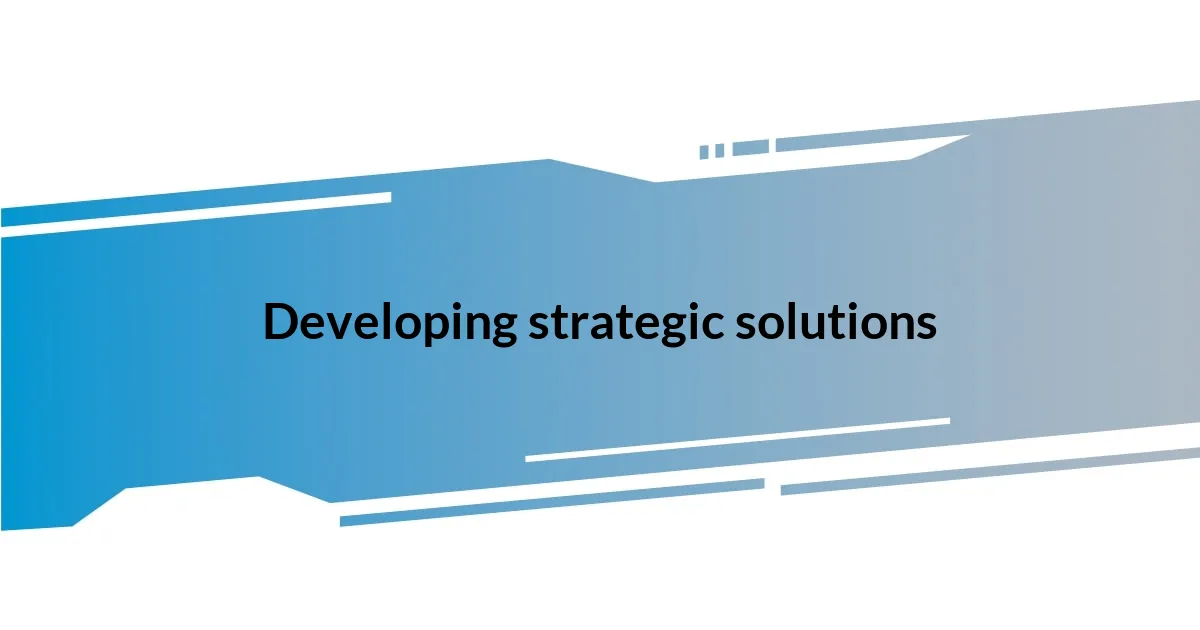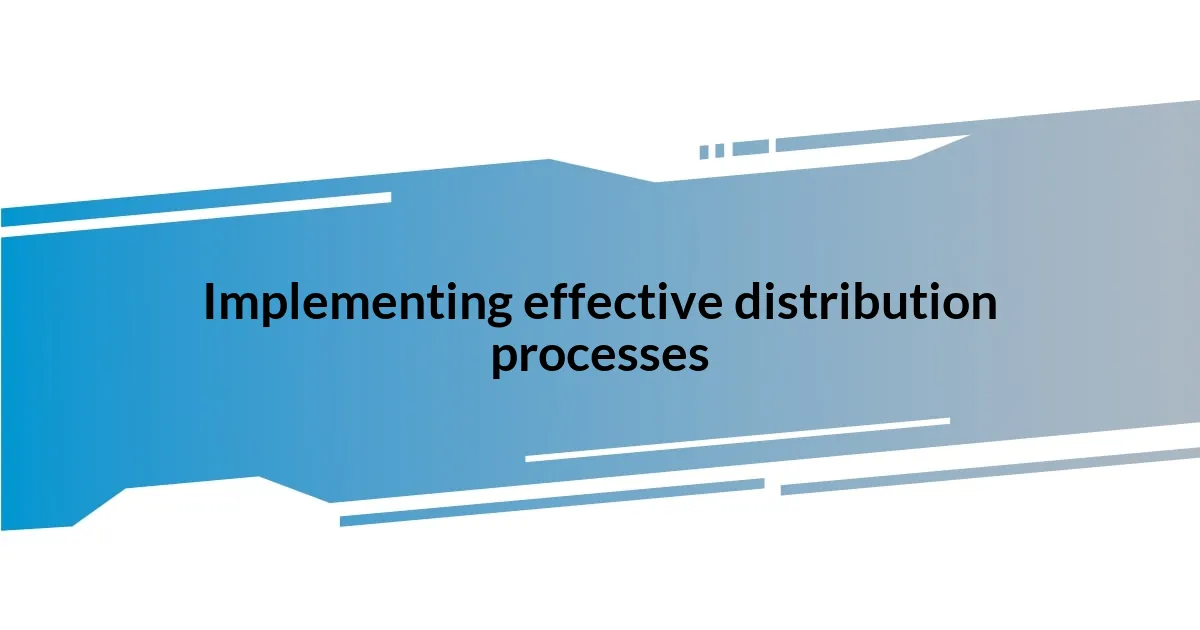Key takeaways:
- Identifying distribution challenges involves analyzing data and feedback to uncover underlying issues, such as miscommunication and outdated technology.
- Developing strategic solutions requires collaboration, flexibility, and embracing technology to create an efficient and resilient distribution process.
- Success in distribution is measured by understanding customer satisfaction and fostering a culture of openness and continuous adaptation among team members.

Identifying distribution challenges
Identifying distribution challenges can often feel overwhelming, especially when you’re faced with unexpected roadblocks that seem to come out of nowhere. I remember a time when a sudden shipment delay sent me into a tailspin—did I order too late? Was my supplier unreliable? It’s those moments of panic that make you realize the importance of clearly understanding every link in your distribution chain.
As I navigated through these challenges, I found that the most effective way to pinpoint issues was to regularly analyze data and gather feedback from my team and customers. What were the recurring themes in their frustrations? Often, we were not just dealing with logistics; there were deeper issues, like miscommunication or lack of inventory visibility, waiting to be uncovered. Seeing the patterns made all the difference, transforming my initial frustration into proactive problem-solving.
Sometimes, the challenges are hidden in plain sight. Have you ever had a seemingly smooth operation suddenly come to a halt? During one of my product launches, I encountered an unexpected regional regulation that had my goods stuck in limbo. It highlighted for me how crucial it is to stay informed about the environments in which we operate. Now, I make it a priority to regularly update my knowledge on regulations and consumer expectations—it’s a small investment that pays off significantly in smoother distribution.

Assessing the root causes
Assessing the root causes is essential when tackling distribution challenges. In my experience, I discovered that root causes were often buried beneath surface problems. For instance, I once assumed that delays were solely due to transportation issues. However, upon further investigation, it became clear that a lack of coordination between my sales team and suppliers was contributing to the chaos. Recognizing this disconnect enabled me to facilitate better communication, ultimately reducing delays.
I also realized that technology played a significant role in my distribution challenges. At one point, I relied heavily on outdated software for inventory management. It didn’t take long before I faced stock discrepancies that puzzled everyone involved. By investing in modern solutions, I found not only a clearer view of my inventory but also a more streamlined process that highlighted additional inefficiencies. The changes were eye-opening, as I had to confront my reluctance to adapt to new technology—a personal lesson in growth.
Sometimes it’s not just about processes; it’s about mindset. There was a time when I accepted challenges as part of the game, but this attitude only masked the real issues. I began asking myself more profound questions: Was I delegating effectively? Were my team members aware of their roles? Embracing a reflective approach helped uncover not only distribution inefficiencies but also enhanced team dynamics. It taught me that resolving challenges is often more about addressing attitudes than merely fixing logistics.
| Potential Root Cause | Example from Experience |
|---|---|
| Poor Communication | Sales and supply teams misaligned on inventory expectations. |
| Outdated Technology | Using old software led to stock discrepancies and confusion. |
| Mindset Issues | A passive response to challenges uncovered deeper team dynamics issues. |

Developing strategic solutions
Developing strategic solutions requires a mix of creativity and analytical thinking. I remember sitting down with my team after a particularly tough quarter, brainstorming fresh ideas to overcome our distribution hurdles. We didn’t just dive into quick fixes; instead, we encouraged everyone to share their unique perspectives. This collaboration allowed us to identify unconventional strategies, such as forming partnerships with local suppliers, which significantly reduced lead times.
Here are a few strategies that proved effective for us:
– Data-Driven Insights: Regularly analyzing sales and inventory data to forecast demand accurately.
– Collaborative Approach: Involving team members from different departments in solution development, fostering diverse ideas.
– Flexibility: Being open to pivoting strategies based on real-time feedback from customers and partners.
– Technology Utilization: Leveraging technology, like automated inventory systems, to enhance visibility and efficiency.
– Community Engagement: Building relationships with local vendors to create a more resilient supply network.
In my experience, incorporating these strategies not only resolved distribution challenges but also nurtured a sense of unity within the team. It reminded me that innovation comes not just from isolated efforts but through shared insights and collective problem-solving. That’s where the real magic lies.

Implementing effective distribution processes
Implementing effective distribution processes starts with clear communication. I once faced a situation where my warehouse staff and sales team were operating on entirely different wavelengths. This disconnect resulted in frequent stockouts and excess inventory. I took it upon myself to establish weekly meeting check-ins, creating a forum for open dialogue that encouraged everyone to voice their concerns and expectations. This adjustment had an incredible impact; not only did it reduce inventory discrepancies, but it also fostered a collaborative culture that energized the team.
In my journey, establishing a reliable distribution process also involved embracing technology. I remember a time when I hesitated to adopt a new inventory management system because I was comfortable with the old ways. But once I made the leap, the difference it made was startling. The real-time tracking features allowed me to anticipate issues before they escalated. I often wondered if I’d ever catch up with the fast-paced changes in the industry, but that moment of transition taught me the value of adaptability. It truly paid off, breathing new life into our operations.
Lastly, I learned that standardizing procedures helped streamline our distribution efforts. Early on, I noticed that variations in how team members approached order fulfillment led to confusion. So, I developed a step-by-step guide and provided training sessions to ensure everyone was on the same page. Seeing the transformation in efficiency was satisfying. Can you imagine how much smoother operations feel when everyone is following the same plan? It’s like having a well-orchestrated symphony, where each player knows their role, resulting in harmony and success.

Measuring success and adaptation
Measuring success in distribution requires more than just tracking numbers; it’s about understanding the story behind those metrics. I vividly remember a time when we celebrated reaching our distribution targets, but I felt a nagging doubt because we lacked insight into our customer feedback. It’s essential to look beyond sales numbers and assess customer satisfaction and engagement; after all, wasn’t the ultimate goal to build lasting connections with our audience? That realization fueled my desire to implement a more comprehensive evaluation system that considered both quantitative and qualitative data.
Adaptation is an ongoing journey, not a destination. During one particularly challenging phase, I introduced what I called “quick retrospectives” after major campaigns. We would gather, not just to analyze what went well but also to embrace failures. It was eye-opening—discussing missteps fostered a culture of openness and encouraged the team to experiment more freely. I found that being vulnerable about setbacks cultivated trust and ignited innovative ideas, as everyone felt empowered to suggest changes without fear. How can one truly grow if they shy away from their imperfections?
I’ve also learned that adaptation isn’t just about fixing what’s broken; it’s about continuous evolution. I recall a time when our market demand shifted unexpectedly, leaving me scrambling for solutions. Instead of resisting change, I started proposing pilot programs to test different approaches on a smaller scale. This proactive mindset not only alleviated my immediate panic but also became a norm in our decision-making process. In my experience, being receptive to change and willing to iterate based on real-world feedback has been the linchpin for sustained success in navigating distribution challenges. Have you ever noticed how the best innovations often stem from simple adjustments?

Lessons learned from the experience
One of the most significant lessons I grasped was the importance of flexibility in my processes. There was an instance when a new supplier I was excited about failed to deliver on time, throwing our distribution schedule into chaos. It was frustrating, but instead of panicking, we quickly identified alternative suppliers and refined our contingency plans. This experience taught me that having backup strategies is essential in an unpredictable business landscape—it’s not just about hoping for the best but being ready to adapt when things go awry.
Another profound insight for me was realizing the power of team ownership in problem-solving. During a particularly rough patch, I involved team members in brainstorming sessions to address distribution issues. I vividly remember how one of our junior staff members suggested a simple tweak in our logistics that saved us a day’s worth of shipping delays. That moment struck me; when you empower people at all levels, you unlock creative solutions that you might not even have considered. Isn’t it incredible how a fresh perspective can change everything?
Lastly, I learned that cultivating relationships with our distribution partners is just as crucial as the systems we implement. After a miscommunication with one of our carriers led to a mishap, I realized the value of proactive communication. I started scheduling regular catch-ups with them, which not only mitigated future misunderstandings but also built a sense of camaraderie. Have you noticed how stronger relationships often lead to smoother operations? In this line of work, it’s these connections that can truly transform challenges into opportunities.

Sharing insights with others
Sharing insights with others has always been a cornerstone of my growth. I remember one particular meeting where I gathered my team to openly discuss our distribution challenges. As we shared our struggles and solutions, it felt almost therapeutic; I could see everyone’s shoulders relax as they voiced their frustrations. It was powerful to witness how such openness not only strengthened our bond but also paved the way for innovative ideas. Why do we often hold back our thoughts when sharing could lead to breakthroughs?
Sometimes, I find that the most insightful exchanges happen outside formal meetings. I once spent a casual lunch with a fellow industry colleague, and in our conversation, we exchanged war stories about distribution setbacks. The insights I gained from that casual chat were invaluable, revealing fresh perspectives I hadn’t considered. Isn’t it fascinating how a simple conversation over a meal can spark lifelong strategies?
Moreover, I believe in the power of storytelling to inspire others. When I share my personal experiences—like the time we turned a major shipping error into an opportunity for improvement—I see how it resonates and encourages peers to reflect on their own experiences. What if we all took a moment to share our stories? The lessons learned could create a ripple effect, inspiring others to navigate their own challenges more effectively. It’s this community of shared insights that truly enhances our collective resilience.
